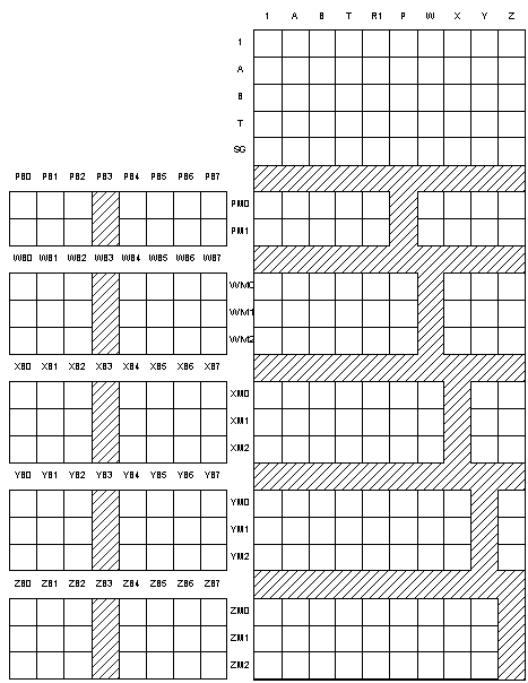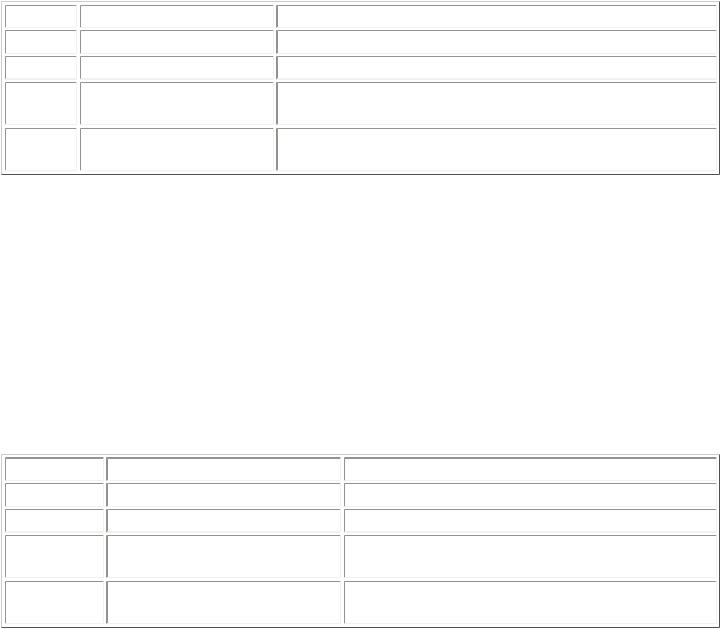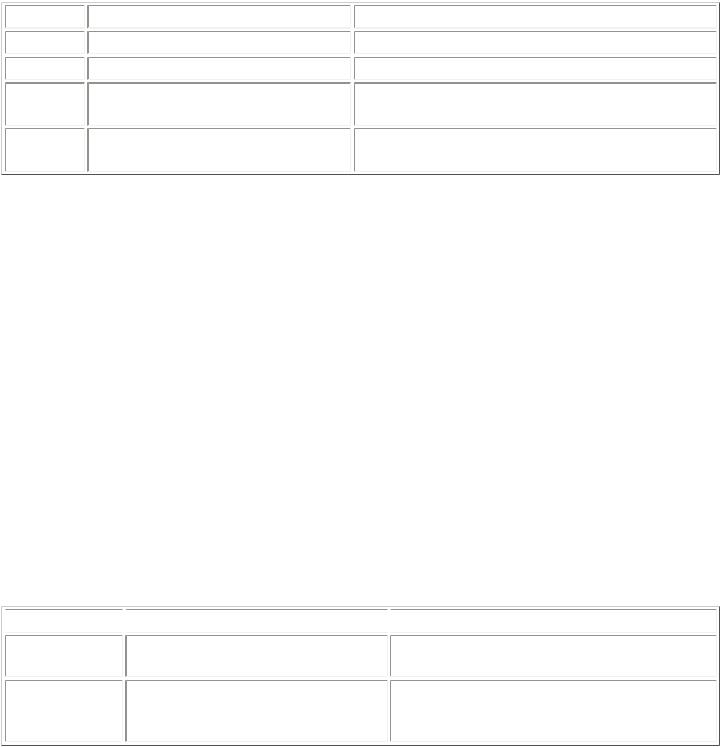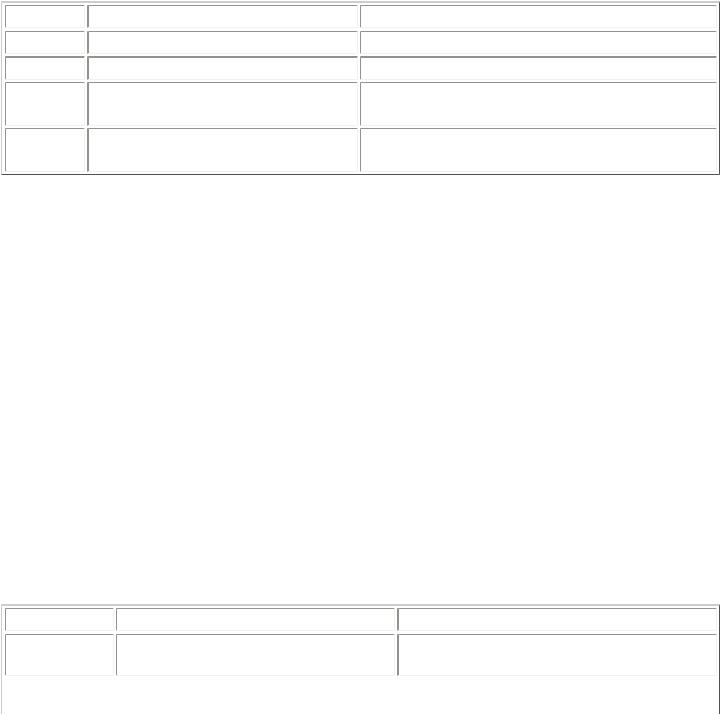Polycom RS-232 User Manual

Installed Voice Business Group
RS-232 Command Set:
Vortex EF2211 Programming Guide
Copyright © 2003 Polycom, Inc.
Polycom and the Polycom logo are registered trademarks of Polycom, Inc.
ASPI, Vortex, VS4000, Viewstation, and iPower are registered trademarks of Polycom, Inc.
All other brand names, product names, and trademarks are the sole property of their respective owners

Vortex EF2211 Programming
Guide
Table of Contents
1.Introduction
2.RS-232 Hardware
3.Programming Tips
3.1.Initialization
3.2.Wildcard Characters
3.3.Using Acknowledgements
3.4.Macros and Presets
4.Command Structure
4.1.Device Type
4.2.Device ID
4.3.Command Name
4.4.Command Data
4.5.Command Terminator
4.6.Examples
5.Status Messages
6.Command Types
6.1.Boolean Commands
6.2.Integer Commands
6.3.Channel Commands
6.4.Matrix Commands
6.5.Miscellaneous Commands
7.Command List
8.Command Reference
8.1.AA -- Enable or Disable Auto Answer Mode
8.2.ACKMOD -- Enable or Disable Acknowledgment Mode
8.3.AEC -- Enable or Disable Acoustic Echo Cancellation
8.4.AECMODE -- Set Amount of Double Talk Suppression used in the AEC.
8.5.AGC -- Enable or Disable Mic/Line Input Automatic Gain Control
8.6.AGCMAX -- Set Maximum Allowed Mic/Line Input AGC Gain
8.7.AGCMIN -- Set Minimum Allowed Mic/Line Input AGC Gain
8.8.AGCRATE -- Set Ramp Rate of Mic/Line Input AGC
8.9.AHCP -- Enable or Disable Call Progress Based Auto Hangup
8.10.AHLD -- Enable or Disable Loop Drop Based Auto Hangup
8.11.AMASGN -- Assign Inputs to an Automixer
8.12.AMAUTO -- Select Automatic or Manual Gating for each Automixer Input
8.13.AMBUSID -- Set Automixer Groupings for EF Bus
8.14.AMCHAIR -- Enable Chairman Mode for Specified Automixer
8.15.AMCHNUM -- Set Chairman Mic
8.16.AMDECAY -- Set Decay Time for Automixers
8.17.AMGATEC -- Set Automixer Gating Control Mode
8.18.AMGATER -- Set Automixer Gate Ratio
8.19.AMGATET -- Set Automixer Gate Threshold
8.20.AMGNOM -- Set Global Maximum Number of Open Mics for Bus Automixer
8.21.AMHOLD -- Set Automixer Hold Time
8.22.AMLMM -- Set Last Mic On Mode for Specified Automixer
8.23.AMLMN -- Set Microphone That Will Remain On in Manual Last Mic On Mode
8.24.AMNOM -- Set Local Maximum Number of Open Mics for Automixer
8.25.AMNOMAT -- Select NOM Attenuation on Each Output
8.26.AMOFFAT -- Set Off Attenuation for the Specified Automixer
8.27.AMPRIOR -- Set Gating Priority for the Specified Mic
8.28.AMREFB -- Set Automixer Reference Bias for the Specified Automixer
8.29.AMREFE -- Enable Automixer Reference for Specified Automixer
8.30.BAUD -- Set Baud Rate for RS-232 Port
8.31.BLAUTO -- Enable Automatic BLDATA Messages
8.32.BLDATA -- Request Level Information
8.33.BLINFO -- Select Information to be Reported in BLDATA
8.34.BROAD2 -- Broadcast Arbitrary Command Strings to RS-232 Port
8.35.BROADA -- Broadcast Commands to Other Connected Devices
8.36.BUSREF -- Set Which AEC Reference is Placed on EF Bus
8.37.CGATE -- Query Camera Gating Status Information
8.38.CGATEEN -- Enable Automatic Camera Gating Messages
8.39.CGATET -- Set Camera Gating Hold Time
8.40.COUNTRY -- Specify Country Definitions for Phone Interface
8.41.DELAYO -- Set Output Delay
8.42.DELAYOE -- Enable Output Delay
8.43.DIAL -- Send DTMF Digits to Phone Interface
8.44.DSPAUTO -- Enable Automatic DSPLOAD Status Messages
8.45.DSPLOAD -- Query Percentage of Variable DSP Resources Used
8.46.ERROR -- Enable or Disable Error Messages
8.47.FADERGIL -- Set Fader Gain of Line Inputs as a Group
8.48.FADERI -- Set Input Gain Fader
8.49.FLASH -- Execute Hook Flash
8.50.FLOW -- Set Flow Control Mode for RS-232 Port
8.51.FPLOCK -- Lock/Unlock Front Panel
8.52.FPPSWD -- Change Front Panel Password
8.53.GAINA -- Set Phone Input Gain
8.54.GAIND -- Set Gain of Incoming DTMF Tones
8.55.GAINDIT -- Set Gain of Incoming DTMF Tones
8.56.GAINDT -- Set Dial Tone Gain
8.57.GAINGIL -- Set Gain of Line Inputs as a Group
8.58.GAINI -- Set Input Gain
8.59.GAINO -- Set Output Gain
8.60.GAINP -- Set Phone Output Gain
8.61.GAINSIT -- Set From Phone User Tone Gain
8.62.GAINSOT -- Set To Phone User Tone Gain
8.63.GATE -- Query Gating Status Information
8.64.GATEEN -- Enable Automatic Gating Messages
8.65.GMUTEO -- Mute All Outputs
8.66.ID -- Set Device ID
8.67.LABEL -- Set or Query one of the Device Labels
8.68.LAGC -- Enable or Disable Line Input Automatic Gain Control
8.69.LAGCLINKAB -- Enable or Disable Stereo AGC Linking on Inputs A and B
8.70.LAGCMAX -- Set Maximum Allowed Line Input AGC Gain
8.71.LAGCMIN -- Set Minimum Allowed Line Input AGC Gain
8.72.LAGCRATE -- Set Ramp Rate of Line Input AGC
8.73.LEC -- Enable or Disable LEC
8.74.LECMODE -- Set Amount of Double Talk Suppression used in the LEC.
8.75.LI -- Query State of Logic Inputs
8.76.LIA -- Assign Action for when Logic Input is Activated
8.77.LID -- Assign Action for when Logic Input is Deactivated
8.78.LIH -- Assign Action for when Logic Input is Held
8.79.LIEN -- Enable Automatic Logic Input Status Messages
8.80.LIG -- Configure Logic Input Pins Into a Group
8.81.LIK -- Delete One or All Logic Input Pin Commands
8.82.LIM -- Mask Logic Input Pins
8.83.LIN -- Assign Command to Logic Input Group
8.84.LIP -- Set Polarity for Logic Inputs
8.85.LO -- Query or Set Status of Logic Output Pins
8.86.LOA -- Define Behavior for Logic Output Activated State
8.87.LOD -- Define Behavior for Logic Output Deactivated Status
8.88.LOEN -- Enable Automatic Logic Output Status Messages
8.89.LOK -- Delete One or All Logic Output Pin Commands
8.90.LOM -- Mask Logic Output Pins
8.91.LOP -- Set Polarity for Logic Outputs
8.92.MACROA -- Add Command to Current Macro
8.93.MACROK -- Delete One or All Macros
8.94.MACROL -- List All Commmands in a Macro
8.95.MACROQ -- Execute Macro Quietly
8.96.MACROS -- Start a New Macro
8.97.MACROW -- Write Macro to Non-Volatile Memory
8.98.MACROX -- Execute Macro
8.99.METER -- Select which Signal is Displayed on the Front Panel LED Meter 8.100. MGAIN -- Set Crosspoint Gains in Main Matrix or Submatrix
8.101. MGATE -- Select Gated or Ungated Microphone Signal in Matrix 8.102. MIC -- Enable Microphone Gain Stage on Input 1
8.103. MINI -- Enable Modem Initialization String
8.104. MINISTR -- Set Modem Initialization String
8.105. MMUTE -- Mute Crosspoint in Main Matrix or Submatrix 8.106. MUTEGIL -- Set Mute Status of Line Inputs as a Group 8.107. MUTEI -- Mute One or More Inputs
8.108. MUTEO -- Mute One or More Outputs 8.109. NC -- Enable Noise Cancellation
8.110. NCL -- Set Noise Cancellation Attenuation
8.111. NVINIT -- Reinitialize Non-Volatile Memory
8.112. NVLOCK -- Lock/Unlock Non-Volatile Memory 8.113. NVPSWD -- Change Non-Volatile Memory Password
8.114. PEQIA -- Set All Parameters for Specified Parametric EQ Input Stage 8.115. PEQIB -- Set Bandwidth Parameter for Specified Parametric EQ Input Stage 8.116. PEQIE -- Set Enabled Parameter for Specified Parametric EQ Input Stage 8.117. PEQIF -- Set Frequency Parameter for Specified Parametric EQ Input Stage 8.118. PEQIG -- Set Gain Parameter for Specified Parametric EQ Input Stage 8.119. PEQIS -- Set Slope Parameter for Specified Parametric EQ Input Stage 8.120. PEQIT -- Set Type Parameter for Specified Parametric EQ Input Stage 8.121. PEQOA -- Set All Parameters for Specified Parametric EQ Output Stage
8.122. PEQOB -- Set Bandwidth Parameter for Specified Parametric EQ Output Stage 8.123. PEQOE -- Set Enabled Parameter for Specified Parametric EQ Output Stage 8.124. PEQOF -- Set Frequency Parameter for Specified Parametric EQ Output Stage 8.125. PEQOG -- Set Gain Parameter for Specified Parametric EQ Output Stage 8.126. PEQOS -- Set Slope Parameter for Specified Parametric EQ Output Stage 8.127. PEQOT -- Set Type Parameter for Specified Parametric EQ Output Stage 8.128. PHANTOM -- Enable Phantom Power on Input 1
8.129. PHONE -- Take Phone On-Hook or Off-Hook 8.130. PING -- See Which Devices Are Present 8.131. PRESETK -- Delete One or All Presets 8.132. PRESETL -- List All Commmands in a Preset
8.133. PRESETP -- Set Which Preset Will Be Activated At Power-Up 8.134. PRESETQ -- Execute a Preset Quietly
8.135. PRESETW -- Save a Preset
8.136. PRESETX -- Execute a Preset
8.137. REDIAL -- Redial the Last Dialed Phone Number 8.138. REFASGN -- Assign AEC Reference to Input Channel 8.139. REFGAIN -- Set Reference Output Gain
8.140. RING -- Enable or Disable Ring Messages 8.141. SGGAIN -- Set Gain of Signal Generator 8.142. SGMUTE -- Mute Signal Generator
8.143. SGTYPE -- Set Type of Signal Produced by Signal Generator 8.144. SOUNDL -- Play Sound Locally
8.145. SOUNDP -- Play Sound to Phone
8.146. SSDELAY -- Set Delay Between Screen Saver Screens 8.147. SSEN -- Enable or Disable Screen Saver
8.148. SSSTART -- Set Idle Time Required for Screen Saver to Start
8.149. SSTEXT -- Set Text to be Displayed by Screen Saver 8.150. SWRESET -- Perform Soft Reset of System
8.151. SWVER -- Query Software Version
8.152. TONEE -- Enable or Disable Entry and Exit Tones 8.153. TONER -- Enable or Disable Ring Tones
8.154. VTXMODI -- Enable VTX Mode on Specified Inputs 8.155. VTXMODO -- Enable VTX Mode on Specified Inputs
1. Introduction
This document describes the command protocol that is used to communicate with the Vortex EF2211 via its RS-232 port.
2. RS-232 Hardware
The communication between the Vortex and a host controller is conducted via the RS-232 port on the back panel of the Vortex. The Vortex's RS-232 port operates at the following settings:
●Bit Rate (bps): 9600 (default), 19200, or 38400
●Data Format: 8 data bits, no parity, 1 stop bit (8N1)
●Flow Control: none (default) or hardware (RTS, CTS)
Note that although the flow control setting is user selectable to none or hardware, hardware flow control must be used when updating the firmware of the Vortex. This means that while a 3-wire RS232 cable (RX, TX, GND) is acceptable for control of the Vortex, the minimum cable for updating firmware should contain 5 wires (RX, TX, RTS, CTS, GND).
3. Programming Tips
3.1. Initialization
During power up of the Vortex device or initialization of the host program, electrical fluctuations on the RS-232 lines may cause the Vortex to receive spurious data. After initialization, the host program should send a few carriage return characters (^M, ASCII 13) to the connected Vortex to flush out any spurious characters it may have received. Failure to do this could result in the Vortex ignoring the first command received after initialization.
As part of the host program initialization, the host will want to synchronize the status of its controls with the current status of the Vortex devices that are being controlled. The host could initialize its controls to default values and then send commands to the Vortexes to set them to the same state. This approach has significant disadvantages since initializing the host program could undo settings made by other host programs or by the front panel controls of one of the linked Vortex devices. A better approach is to query the linked Vortex devices for their status and set the host program controls based on the return values.
3.2. Wildcard Characters
The use of the wildcard character, '*', can make programming the host controller much easier. Be careful when using wildcards, however, since they can generate a lot of traffic on the digital bus.
3.3. Using Acknowledgements
It is a good idea for the host program or control system to make sure that all connected Vortex devices have acknowledgment mode enabled (see the ACKMOD command). When acknowledgment
mode is on, a Vortex device will send an acknowledgment for each command it receives. Proper use of acknowledgments makes the host program more robust and makes supporting multiple hosts effortless. The rest of this section describes how to use acknowledgments to achieve these goals.
As a convenient example, let us imagine a host program with a graphical user interface (GUI). The user presses buttons on the GUI to enable or disable features of various linked Vortex devices. The buttons on the GUI reflect the current status of the corresponding feature.
When the user presses a button on the GUI to enable or disable a feature, the host program should send the corresponding command to the selected Vortex device. It may be tempting to update the status of the GUI button at this point, but this can cause problems if there are transmission errors or if there are multiple host controllers. The proper way to handle this is to only update the GUI controls based on acknowledgments received from the Vortex device.
To implement this, organize your code so that the functions that send commands are totally separate from the functions that receive responses from the Vortex devices. This also enables your host program to support the presence of multiple host controllers. For example, consider the following sequence of events.
1.Another host sends a command to a Vortex device.
2.The Vortex device responds with an acknowledgment that is broadcast to all of the other hosts.
3.Your host program receives the acknowledgment and updates the status of the corresponding control.
The result of this programming model is that all hosts and linked Vortex devices will always be synchronized.
For simple on/off features, your host program can make use of the toggle arguments to some commands (e.g., 'SSEN2'). By sending a toggle command when a button is pressed, and updating the button based on acknowledgments, your host program will not have to keep track of the status of the button.
In a similar fashion, many of the integer commands (such as gains) can be controlled by incrementing or decrementing them by a specific amount. For example, the command 'GAINIA>1 ' increments the input gain on channel A by 1 dB. The acknowledgment for this command will return the actual value that the gain was incremented to. Thus, to implement a volume control, your control program can send a command to increment the gain by 1 dB when the "up" button is pressed and decrement the gain by 1 dB when the "down" button is pressed. The control can update its level indicator based on the acknowledgment that is received.

3.4. Macros and Presets
Although macros and presets are similar, there are times when using one is better than the other. Presets store the absolute values of all of the non-global settings of the device. This includes, but is not limited to, input and output gain settings, matrix settings, algorithm settings, parametric EQ settings, and automixer settings. See Section 7 for a list showing all the commands and which are
saved to presets.
Presets should be used when you really want to change all the settings in a device. One example would be when you want to have one unit be able to control different rooms. In this case, having a preset for each different room is the easiest solution.
Macros are like mini-presets. You can define them to change only the settings you are interested in. One advantage of macros over presets is that macros can make relative changes in addition to absolute changes. An absolute change is something like "set the input gain to -3 dB". A relative change is something like "raise the input gain by 3 dB". One example of using macros for a relative change is stereo volume ramping. If you have two outputs setup to have left and right program audio, then you could build a macro that contains two commands: one to increment the left channel by 1 dB and the other to increment the right channel by 1 dB. Then, by calling that macro, you can ramp the stereo outputs. A similar thing can be done with decreasing the volume.
Another thing to consider when using macros and presets is to use the MACROQ and PRESETQ commands instead of the MACROX and PRESETX commands. Both the Q and X versions execute the
macro or preset, but the X versions produce acknowledgements for the settings that change, while the Q versions don't. If your control system updates its status by looking at the acknowledgements that come back, then you'll probably want to use the X versions. Another option would be to use the Q versions and then manually query the values you're interested in. If your control system does not need use acknowledgements, or if you are manually querying the values you're interested in, using the Q versions is better since it doesn't generate acknowledgements and thus reduces RS-232 traffic.
4. Command Structure
A Vortex command consists of a series of ASCII characters with the following structure.
Description |
Number of Characters |
Range of Values |
Device Type |
1 |
0-9, A-Z, * |
Device ID |
2 |
0-9, * |
Command Name |
1-7 |
0-9, A-Z |
Command Data |
0-64 |
ASCII characters |
Command Terminator |
1 |
^M (ASCII 13) |
4.1. Device Type

A single alphanumeric character is used to indicate the device type. The devices in Polycom's EchoFree family have the following device types.
Device |
Device Type |
EF200 |
A |
EF1210 |
C |
EF2280 |
F |
EF2241 |
B |
EF2211 |
S |
EF2210 |
Q |
EF2201 |
T |
Device type '*' can be used to send a command to all device types simultaneously.
4.2. Device ID
Two numeric characters are used to indicate the device ID. The Vortex can be configured for device IDs from '00' to '07'. Note that even though the device ID is less than 10, the leading '0' must be included. Device ID '**' can be used to send a command to all device IDs simultaneously. Some examples of using wildcard characters are given below.
●'S**' broadcasts to all EF2211 devices that are linked together.
●'*07' broadcasts to all devices with device ID 07 (this format is not commonly used).
●'***' broadcasts to all devices that are linked together.
4.3. Command Name
The command name can be from 1 to 7 characters long. Command names will be specific to device types. In other words, the EF2280 has its own command set, which is different from the EF2241's, which is different from the EF1210's, etc. There are some commands, such as 'PING', that are common among all the various command sets.
4.4. Command Data
The command data is a series of 0-64 characters containing payload data for the command. Obviously, the command data will be specific to the command type. note that the maximum number of payload characters for the EF200 and EF1210 is 32, but the Vortex devices support up to 64 characters in the payload. This increase was necessary to accommodate the matrix gain and macro/preset commands.
4.5. Command Terminator
The command terminator is a single character indicating the end of a command. ASCII 13 (^M) was

chosen as the terminator to allow manually typing commands using a simple text terminal.
4.6. Examples
In the following examples, Vortex commands are enclosed in single quotes, 'like this'. Also, the terminator character is not explicitly shown, but its presence is implied.
Consider the command '***PING'. The device type and ID for this command are wildcards, thus the command will be sent to all devices. The command name in this case is 'PING', and there are no data characters (payload). Note that the 'PING' command is supported by all of the Vortex devices, thus broadcasting the command to all devices makes sense.
Consider the command 'S**GAINIA10'. The device type for this command is 'S' and the device ID is a wildcard, thus the command will be broadcast to all EF2211 devices linked together. The command name in this case is 'GAINIA' and the command data (payload) is '10'. This command sets the gain on input A of all connected EF2211's to 10 dB.
Command |
Effects |
***PING |
Requests PONG response from all linked Vortex devices. |
S**GAINIA10 |
Sets the gain on input A of all connected EF2211 devices to 10 dB. |
5. Status Messages
The Vortex sends status messages via RS-232 and EF Bus any time one of its internal parameters changes. This means that the host program does not need to continually poll the Vortex in order to detect status changes. Status messages are in the same format as the commands used to set the corresponding parameter.
For example, suppose you send the command 'S**GAINIA10' and there are two EF2211's linked together with device IDs 3 and 7. The EF2211's will respond with 'S03GAINIA10' and 'S07GAINIA10', respectively. Now, someone uses the front panel of the EF2211 set to ID 7 to decrease input A's gain by 1 dB. When this happens, the EF2211 will respond with 'S07GAINIA9'. This example illustrates that status messages can be sent as the result of an RS-232 command or as the result of some other change in the Vortex device such as front panel adjustments, logic inputs, etc.
Status messages can be turned off via the ACKMOD command. ACKMOD refers to acknowledgement mode since the term status message and acknowledgement are synonymous for our purposes.
6. Command Types
Many of the Vortex commands have similar formats. The main formats are described here in order to provide a better understanding of the command set.
6.1. Boolean Commands
Boolean commands take one of the three following arguments.
●'0' indicates that the parameter should be turned off.
●'1' indicates that the parameter should be turned on.
●'2' indicates that the parameter should be toggled (i.e., '0' becomes '1' and '1' becomes '0').
Parameters associated with boolean commands can be queried using the '?' character. For example, if input A is muted, and you send ' S04MUTEIA? ', the EF2211 will respond with a status message of ' S04MUTEIA1 '. When a status message is generated for a boolean command, the command data will either be a '0' or '1', since '2' is obviously not a valid state.
6.2. Integer Commands
Integer commands can take one of two types of arguments. The first argument type is absolute, meaning that the parameter will be set to the specified number. For example, ' S04GAINIA10 ' means that the gain on input A will be set to 10 dB. In this case, the device will respond with a status message of ' S04GAINIA10 '.
The second argument type is relative, meaning that the parameter will be incremented or decremented by the specified amount. The increment character is '>' and the decrement character is '<'. For example, ' S04GAINIA>3 ' increments the gain on input A by 3 dB. If the input's gain was previously set to 6 dB, then it would now be set to 9 dB. In this case the device would respond with a status message of ' S04GAINIA9 '.
The numeric part of both the absolute and relative arguments can contain a '+' or '-' to indicate the algebraic sign of the argument. If no sign is given, '+' is assumed.
The parameters associated with integer commands have maximum and minimum values associated with them. If you try to set a parameter above its maximum or below its minimum, the parameter will be set to its maximum or minimum value, respectively.
Parameters associated with integer commands can be queried using the '?' character. For example, if input A 's gain is set to 12, and you send ' S04GAINIA? ', the device will respond with a status message of ' S04GAINIA12 '.
6.3. Channel Commands
A command can be a channel command in addition to being one of the other types of commands (integer or boolean). A channel command means that the command applies to a specific input or output channel. The channel is specified by a single character (e.g., '1', 'A', 'B', etc.) occurring before any other payload data.
An example of a boolean channel command is the 'AGC' (Automatic Gain Control) command. ' S04AGC10 ' disables the AEC on input channel 1 . After sending this command, the device will
respond with a status message of ' S04AGC10 '.
An example of an integer channel command is the 'GAINI' command, which adjusts the gain on the
input channels. ' S04GAINIA12 ' sets the input gain of channel A to 12 dB. After sending this command, the device will respond with a status message of ' S04GAINIA12 '.
A wildcard character ('*') can be used as the channel specifier for many of the channel commands. If this is the case, there are two options for specifying the values for the channels. The first method is to specify a single value that will be applied to all the channels.
Take the MUTEI command for example: ' S04MUTEI*1 ' mutes input channels 1 and A-B After
sending this command, the device will respond with a status message of ' S04MUTEI*111 '. In this status message, the device reports the status of all the channels. Since the MUTEI command applies to channels 1 and A-B the status of all 3 channels. The first (left most) value corresponds to channel 1 and the last (right most) value corresponds to channel B.
This leads us to the second method of using a wildcard character: specifying the values for each of the channels. For example, ' S04MUTEI*101 ' mutes channels 1, B and unmutes channel A. In this case, the device will respond with a status message of ' S04MUTEI*101 '.
As an interesting example, consider sending ' S04MUTEI*2 ' after the above example. The device will respond with a status message of ' S04MUTEI*010 '. Notice that all the states have been toggled.
Queries using the '?' character are straightforward. For example, ' S04MUTEI1? ' might return '
S04MUTEI11 ', while ' S04MUTEI*? ' might return ' S04MUTEI*100 '.
Using the wildcard character with integer channel commands is similar to using it with boolean commands, but there are some differences. If we sent ' S04GAINI*10 ', the input gains on channels 1 and A-B will all be set to 10 dB. The device will respond with a status message of ' S04GAINI*ÄÄÄ '. Those weird characters are the main difference between using wildcards with integer channel commands versus boolean channel commands. When reporting multiple integer values, the Vortex uses a binary format with one byte per integer value. This allows for more compact commands and reduces RS-232 and bus traffic. To convert from an integer value to a byte value, we add 132 to the integer value. In the above example, where the gain is set to 10 dB, we have: 10 + 132 = 142 = 0x8E (hex) = Ä (ASCII). The reason for adding 132 is to allow us to conveniently represent negative numbers as well as avoid the use of special characters that are normally used in RS-232 and EF Bus communications.
When using a wildcard character to specify separate values for each channel, you must also use the binary format. For example, ' S04GAINI*Äää ' sets the input gain of channel 1 to 10 dB and the input gain of channels A-B to 0 dB. (10 + 132 = 142 = 0x8E (hex) = Ä (ASCII), 0 + 132 = 132 = 0x84 (hex) = ä (ASCII))
As an interesting example, consider sending ' S04GAINI*>3 ' after the above example. This will result in all the input gains being incremented by 3 dB so that channel 1 is at 13 dB and channels A-B are at 3 dB. The Vortex will respond with a status message of ' S04GAINI*æçç '. (13 + 132 = 145 = 0x91 (hex) = æ (ASCII), 3 + 132 = 135 = 0x87 (hex) = ç (ASCII))

Queries using the '?' character are straightforward. For example, ' S04GAINI1? ' might return '
S04GAINI110 ', while ' S04GAINI*? ' might return ' S04GAINI*Äää '.
6.4. Matrix Commands
Matrix commands are used for controlling parameters that exist at the crosspoints of the mixing matrices. Typical parameters include gain and mute. Before describing the matrix commands, it is necessary to give a description of the matrices involved. During the following discussion, it will be helpful to refer to the figure below, which shows all the matrices with their input and output labels.
The EF2211 has three analog outputs labeled 1, A, and B. These outputs are all at line level. There are two additional outputs: the output to the telephone interface, labeled T, and the output to the power amplifier. The output to the power amplifier does not have a separate output in the matrix, it is

tied to output 1. Thus the signal routed to output 1 will also be routed to the power amplifier output. This yields a total of four physical outputs.
The EF2211 has three analog inputs labeled 1, A, and B. Input 1 is mic/line selectable, and inputs A-B are line level only. Input 1 can also have phantom power enabled and contain channel processing, which includes the following DSP algorithms: Acoustic Echo Cancellation, Noise Cancellation, and AGC. An additional input, labeled T, comes from the telephone interface. The T input also has signal processing which includes the following algorithms: Line Echo Cancellation, Noise Cancellation, and AGC. Inputs 1, A, B, and T yield a total of 4 physical inputs.
Vortex devices can be linked together so that they can share control information and digital audio signals. The audio signals are shared on four digital busses labeled P, W, X, Y, and Z. All Vortex devices can receive signals from all of these busses. Only certain devices can transmit on the busses. This information is given in the following table.
Device Transmit on P Bus |
Transmit on W, X, Y, Z |
Receive P Bus |
Receive W, X, Y, Z |
Busses |
Busses |
||
EF2280 No |
Yes |
Yes |
Yes |
EF2241 Yes |
Yes |
Yes |
Yes |
EF2211 Yes |
Yes |
Yes |
Yes |
EF2210 No |
Yes |
Yes |
Yes |
EF2201 Yes |
No |
Yes |
Yes |
The P bus is meant for routing telephone audio between the devices. The W, X, Y, and Z busses are meant for routing microphone and auxiliary audio between the devices. The W, X, Y, and Z busses also carry NOM (Number of Open Microphones) information from the automixer so that outputs created from these busses can be appropriately attenuated for the number of open microphones.
The digital inputs consist of all of the signals placed on the EF Bus by the other connected Vortex devices. Each P, W, X, Y, and Z bus can carry channels from up to eight other devices, so we have the following digital inputs to each Vortex device: PB0-PB7, WB0-WB7, XB0-XB7, YB0-YB7, and ZB0-ZB7. The inputs are designated by three characters: the bus letter (P, W, X, Y, or Z), a B indicating that it is a bus input, and a number between 0 and 7 indicating the channel of the bus.
There is also an internal signal generator, labeled SG, that is capable of producing white or pink noise. this signal is fed into the matrix so that it can be routed to the appropriate outputs for calibration or testing.
The mixing capabilities of the Vortex devices can be broken down into two parts: the EF Bus submatrices and the main matrix.
For each of the W, X, Y, and Z signal busses, there is a 7 x 3 matrix that allows the user to define up to three mixes of each of the four signal busses. The reason the matrix is 7 x 3 instead of 8 x 3 is that since we can transmit on the W, X, Y, and Z busses, we do not need to mix our own channels in these matrices. The inputs and outputs for the 7 x 3 matrices are as follows.
W Submatrix
●Inputs: WB0-WB7 (with one invalid)
●Outputs: WM0-WM2
XSubmatrix
●Inputs: XB0-XB7 (with one invalid)
●Outputs: XM0-XM2
YSubmatrix
●Inputs: YB0-YB7 (with one invalid)
●Outputs: YM0-YM2
ZSubmatrix
●Inputs: ZB0-ZB7 (with one invalid)
●Outputs: ZM0-ZM2
For the P signal, bus there is a 7 x 2 matrix that allows the user to define up to two mixes of the P signal bus. The reason the matrix is 7 x 2 instead of 8 x 2 is that since we can transmit on the P bus, we do not need to mix our own channels in this matrix. The inputs and outputs for the 7 x 2 P bus matrix are as follows.
PSubmatrix
●Inputs: PB0-PB7 (with one invalid)
●Outputs: PM0-PM1
The crosspoint gains on all outputs are user adjustable. The "M" in the output labels of the submatrices indicates that the signals are being fed into the Main Matrix.
The main matrix consists of the following inputs: analog inputs 1, A, and B, the telephone input T, the signal generator (SG), the outputs of the EF Bus submatrices PM0-PM1, WM0-WM2, XM0-XM2, YM0YM2, and ZM0-ZM2. This is a total of 19 inputs.
The main matrix consists of the following outputs: analog outputs 1, A, and B, the output to the telephone interface T, AEC reference signal R1, and the EF bus outputs P, W, X, Y, and Z. This is a total of 10 outputs.
The matrix commands can adjust two types of parameters: integer and boolean. We will introduce the matrix commands by using the MGAIN command as an example. This is an integer matrix command that is used to set the gain (in dB) at any of the crosspoints in the main matrix or EF Bus submatrices.
Matrix commands are similar to channel commands except that instead of specifying a single channel, it is necessary to specify a crosspoint (or range of crosspoints). In order to specify a single crosspoint, you use the input and output labels discussed in this section. The first label always specifies the input to the matrix and the second label always specifies the output of the matrix. For example, to set the gain of the crosspoint (1, A) to -3 dB, you would send ' S04MGAIN1,A,-3 ' which sets the gain at the crosspoint to -3 dB. In this case, a status message will be generated similar to ' S04MGAIN1,A,-3 '.
It is also possible to use the wildcard character ('*') to specify ranges of crosspoints with the matrix commands. The only restriction is that you can only use a wildcard to specify the input or output, but not both simultaneously. Thus you could specify all the inputs going to a specific output (one column) or the value of an input to all of the outputs (one row), but not the entire matrix. One example of using a wildcard for an integer matrix command would be ' S04MGAINSG,*,0 '. This will set all the crosspoints in the signal generator row of the main matrix to 0 dB. Thus, the signal generator will be added to all of the outputs of the main matrix with a gain of 0 dB. In this case a status message will be generated that looks like ' S04MGAINSG,*,дддддддддд '. The binary representation used here is the same method described in Section 6.3.
You can also use the wildcard character to set the crosspoints of a row or column individually. For example, 'S04MGAIN1,*,äzzzxxxxxx' sets the crosspoints of input 1 to 0 dB for output 1, -10 dB for outputs A, B and T, and -12 dB for outputs R1, P, and W-Z. In this case, the EF2211 will respoind with a status message of 'S04MGAIN1,*,äzzzxxxxxx'.
Queries using the '?' character work in the usual manner. For example, ' S04MGAIN1,A,? ' might return ' S04MGAIN1,A,-6 ', while ' S04MGAIN1,*,? ' might return ' S04MGAIN2,*,дддддддддд '.
Boolean matrix commands work as you would expect. They use the characters '0', '1', and '2' as described in Section 6.1. Here are some examples.
●' S04MMUTE1,A,1 ' mutes crosspoint (1, A) of the main matrix. In other words, the signal at input 1 will not be heard on output A A status message will be generated of the form '
S04MMUTE1,A,1 '.
●'S04MMUTEA,*,1110000000' sets the mutes for input A of the main matrix. The signal path from input A to outputs 1, A, and B is muted, while the signal path from input A to outputs T, R1, P, and W-Z is unmuted. The EF2211 will respond with a status message of 'S04MMUTEA,*,1110000000'.
●'S04MMUTEA,*,2' toggles the mutes for input A of the main matrix. If this command follows after the command in the above example, the EF2211 will respond with a status message of 'S04MMUTEA,*,0001111111'.
●'S04MMUTEA,*,?' queries the status of the mutes for input A of the main matrix. If this command follows after the commands in the above examples, the EF2211 will respond with a status message of 'S04MMUTEA,*,0001111111'.
6.5. Miscellaneous Commands
Miscellaneous commands are those that don't fall under any of the other categories. See the description of a given command for specific details on how it operates.
7. Command List
The following table is a list of the commands recognized by the EF2211 Detailed descriptions of each command are given in the next section.

The Storage column contains one of the following values indicating when and where the parameter is stored.
●"Global"
●"Preset"
●"-" = not stored or not applicable
Globally stored parameters are not changed when a preset is executed. Only one copy of a global parameter is stored. Global parameters are written to non-volatile memory each time they are changed. Globally stored parameters retain their values when the power is cycled.
Parameters stored in presets are changed each time a new preset is restored/executed. Preset parameters are not saved in non-volatile memory until a PRESETW command is executed. Parameters
stored in the power-on preset (see PRESETP) are restored when the power is cycled.
 Command
Command
AA
 ACKMOD
ACKMOD
AEC
 AECMODE AGC
AECMODE AGC
 AGCMAX
AGCMAX
AGCMIN
 AGCRATE AHCP
AGCRATE AHCP
 AHLD
AHLD
AMASGN
 AMAUTO AMBUSID
AMAUTO AMBUSID
 AMCHAIR AMCHNUM
AMCHAIR AMCHNUM
 AMDECAY AMGATEC
AMDECAY AMGATEC
 AMGATER AMGATET
AMGATER AMGATET
 AMGNOM
AMGNOM
AMHOLD
 AMLMM
AMLMM
AMLMN
Storage |
Description |
Preset |
Enable or Disable Auto Answer Mode |
Global |
Enable or Disable Acknowledgment Mode |
Preset |
Enable or Disable Acoustic Echo Cancellation |
Preset |
Set Amount of Double Talk Suppression used in the AEC. |
Preset |
Enable or Disable Mic/Line Input Automatic Gain Control |
Preset |
Set Maximum Allowed Mic/Line Input AGC Gain |
Preset |
Set Minimum Allowed Mic/Line Input AGC Gain |
Preset |
Set Ramp Rate of Mic/Line Input AGC |
Preset |
Enable or Disable Call Progress Based Auto Hangup |
Preset |
Enable or Disable Loop Drop Based Auto Hangup |
Preset |
Assign Inputs to an Automixer |
Preset |
Select Automatic or Manual Gating for each Automixer Input |
Preset |
Set Automixer Groupings for EF Bus |
Preset |
Enable Chairman Mode for Specified Automixer |
Preset |
Set Chairman Mic |
Preset |
Set Decay Time for Automixers |
Preset |
Set Automixer Gating Control Mode |
Preset |
Set Automixer Gate Ratio |
Preset |
Set Automixer Gate Threshold |
Preset |
Set Global Maximum Number of Open Mics for Bus Automixer |
Preset |
Set Automixer Hold Time |
Preset |
Set Last Mic On Mode for Specified Automixer |
Preset |
Set Microphone That Will Remain On in Manual Last Mic On Mode |

 AMNOM AMNOMAT
AMNOM AMNOMAT
 AMOFFAT AMPRIOR
AMOFFAT AMPRIOR
 AMREFB AMREFE
AMREFB AMREFE
 BAUD BLAUTO
BAUD BLAUTO
 BLDATA BLINFO
BLDATA BLINFO
 BROAD2 BROADA
BROAD2 BROADA
 BUSREF CGATE
BUSREF CGATE
 CGATEEN CGATET
CGATEEN CGATET
 COUNTRY DELAYO
COUNTRY DELAYO
 DELAYOE DIAL
DELAYOE DIAL
 DSPAUTO DSPLOAD
DSPAUTO DSPLOAD
 ERROR FADERGIL
ERROR FADERGIL
 FADERI FLASH
FADERI FLASH
 FLOW FPLOCK
FLOW FPLOCK
 FPPSWD GAINA
FPPSWD GAINA
 GAIND GAINDIT
GAIND GAINDIT
 GAINDT GAINGIL
GAINDT GAINGIL
Preset |
Set Local Maximum Number of Open Mics for Automixer |
Preset |
Select NOM Attenuation on Each Output |
Preset |
Set Off Attenuation for the Specified Automixer |
Preset |
Set Gating Priority for the Specified Mic |
Preset |
Set Automixer Reference Bias for the Specified Automixer |
Preset |
Enable Automixer Reference for Specified Automixer |
Global |
Set Baud Rate for RS-232 Port |
Preset |
Enable Automatic BLDATA Messages |
- |
Request Level Information |
Preset |
Select Information to be Reported in BLDATA |
- |
Broadcast Arbitrary Command Strings to RS-232 Port |
- |
Broadcast Commands to Other Connected Devices |
Preset |
Set Which AEC Reference is Placed on EF Bus |
- |
Query Camera Gating Status Information |
Preset |
Enable Automatic Camera Gating Messages |
Preset |
Set Camera Gating Hold Time |
Global |
Specify Country Definitions for Phone Interface |
Preset |
Set Output Delay |
Preset |
Enable Output Delay |
- |
Send DTMF Digits to Phone Interface |
- |
Enable Automatic DSPLOAD Status Messages |
- |
Query Percentage of Variable DSP Resources Used |
Global |
Enable or Disable Error Messages |
Preset |
Set Fader Gain of Line Inputs as a Group |
Preset |
Set Input Gain Fader |
- |
Execute Hook Flash |
Global |
Set Flow Control Mode for RS-232 Port |
Global |
Lock/Unlock Front Panel |
- |
Change Front Panel Password |
Preset |
Set Phone Input Gain |
Preset |
Set Gain of Incoming DTMF Tones |
Preset |
Set Gain of Incoming DTMF Tones |
Preset |
Set Dial Tone Gain |
Preset |
Set Gain of Line Inputs as a Group |

 GAINI
GAINI
GAINO
 GAINP
GAINP
GAINSIT
 GAINSOT
GAINSOT
GATE
 GATEEN
GATEEN
GMUTEO
 ID
ID
LABEL
 LAGC LAGCLINKAB
LAGC LAGCLINKAB
 LAGCMAX
LAGCMAX
LAGCMIN
 LAGCRATE LEC
LAGCRATE LEC
 LECMODE
LECMODE
LI
 LIA
LIA
LID
 LIH
LIH
LIEN
 LIG
LIG
LIK
 LIM
LIM
LIN
 LIP
LIP
LO
 LOA
LOA
LOD
 LOEN
LOEN
LOK
 LOM
LOM
LOP
Preset |
Set Input Gain |
Preset |
Set Output Gain |
Preset |
Set Phone Output Gain |
Preset |
Set From Phone User Tone Gain |
Preset |
Set To Phone User Tone Gain |
- |
Query Gating Status Information |
Preset |
Enable Automatic Gating Messages |
Preset |
Mute All Outputs |
Global |
Set Device ID |
Global |
Set or Query one of the Device Labels |
Preset |
Enable or Disable Line Input Automatic Gain Control |
Preset |
Enable or Disable Stereo AGC Linking on Inputs A and B |
Preset |
Set Maximum Allowed Line Input AGC Gain |
Preset |
Set Minimum Allowed Line Input AGC Gain |
Preset |
Set Ramp Rate of Line Input AGC |
Preset |
Enable or Disable LEC |
Preset |
Set Amount of Double Talk Suppression used in the LEC. |
Global |
Query State of Logic Inputs |
Global |
Assign Action for when Logic Input is Activated |
Global |
Assign Action for when Logic Input is Deactivated |
Global |
Assign Action for when Logic Input is Held |
Preset |
Enable Automatic Logic Input Status Messages |
Global |
Configure Logic Input Pins Into a Group |
Global |
Delete One or All Logic Input Pin Commands |
Preset |
Mask Logic Input Pins |
Global |
Assign Command to Logic Input Group |
Global |
Set Polarity for Logic Inputs |
- |
Query or Set Status of Logic Output Pins |
Global |
Define Behavior for Logic Output Activated State |
Global |
Define Behavior for Logic Output Deactivated Status |
Preset |
Enable Automatic Logic Output Status Messages |
Global |
Delete One or All Logic Output Pin Commands |
Preset |
Mask Logic Output Pins |
Global |
Set Polarity for Logic Outputs |

 MACROA MACROK
MACROA MACROK
 MACROL MACROQ
MACROL MACROQ
 MACROS MACROW
MACROS MACROW
 MACROX METER
MACROX METER
 MGAIN
MGAIN
MGATE
 MIC
MIC
MINI
 MINISTR
MINISTR
MMUTE
 MUTEGIL
MUTEGIL
MUTEI
 MUTEO
MUTEO
NC
 NCL NVINIT
NCL NVINIT
 NVLOCK NVPSWD
NVLOCK NVPSWD
 PEQIA
PEQIA
PEQIB
 PEQIE
PEQIE
PEQIF
 PEQIG
PEQIG
PEQIS
 PEQIT
PEQIT
PEQOA
 PEQOB
PEQOB
PEQOE
 PEQOF
PEQOF
PEQOG
- |
Add Command to Current Macro |
Global |
Delete One or All Macros |
- |
List All Commmands in a Macro |
- |
Execute Macro Quietly |
- |
Start a New Macro |
Global |
Write Macro to Non-Volatile Memory |
- |
Execute Macro |
Preset |
Select which Signal is Displayed on the Front Panel LED Meter |
Preset |
Set Crosspoint Gains in Main Matrix or Submatrix |
Preset |
Select Gated or Ungated Microphone Signal in Matrix |
Preset |
Enable Microphone Gain Stage on Input 1 |
Global |
Enable Modem Initialization String |
Global |
Set Modem Initialization String |
Preset |
Mute Crosspoint in Main Matrix or Submatrix |
Preset |
Set Mute Status of Line Inputs as a Group |
Preset |
Mute One or More Inputs |
Preset |
Mute One or More Outputs |
Preset |
Enable Noise Cancellation |
Preset |
Set Noise Cancellation Attenuation |
- |
Reinitialize Non-Volatile Memory |
Global |
Lock/Unlock Non-Volatile Memory |
- |
Change Non-Volatile Memory Password |
Preset |
Set All Parameters for Specified Parametric EQ Input Stage |
Preset |
Set Bandwidth Parameter for Specified Parametric EQ Input Stage |
Preset |
Set Enabled Parameter for Specified Parametric EQ Input Stage |
Preset |
Set Frequency Parameter for Specified Parametric EQ Input Stage |
Preset |
Set Gain Parameter for Specified Parametric EQ Input Stage |
Preset |
Set Slope Parameter for Specified Parametric EQ Input Stage |
Preset |
Set Type Parameter for Specified Parametric EQ Input Stage |
Preset |
Set All Parameters for Specified Parametric EQ Output Stage |
Preset |
Set Bandwidth Parameter for Specified Parametric EQ Output Stage |
Preset |
Set Enabled Parameter for Specified Parametric EQ Output Stage |
Preset |
Set Frequency Parameter for Specified Parametric EQ Output Stage |
Preset |
Set Gain Parameter for Specified Parametric EQ Output Stage |

 PEQOS
PEQOS
PEQOT
 PHANTOM
PHANTOM
PHONE
 PING PRESETK
PING PRESETK
 PRESETL PRESETP
PRESETL PRESETP
 PRESETQ PRESETW
PRESETQ PRESETW
 PRESETX REDIAL
PRESETX REDIAL
 REFASGN REFGAIN
REFASGN REFGAIN
 RING SGGAIN
RING SGGAIN
 SGMUTE SGTYPE
SGMUTE SGTYPE
 SOUNDL SOUNDP
SOUNDL SOUNDP
 SSDELAY SSEN
SSDELAY SSEN
 SSSTART SSTEXT
SSSTART SSTEXT
 SWRESET
SWRESET
SWVER
 TONEE
TONEE
TONER
 VTXMODI VTXMODO
VTXMODI VTXMODO
Preset |
Set Slope Parameter for Specified Parametric EQ Output Stage |
Preset |
Set Type Parameter for Specified Parametric EQ Output Stage |
Preset |
Enable Phantom Power on Input 1 |
- |
Take Phone On-Hook or Off-Hook |
- |
See Which Devices Are Present |
Global |
Delete One or All Presets |
- |
List All Commmands in a Preset |
Global |
Set Which Preset Will Be Activated At Power-Up |
- |
Execute a Preset Quietly |
Global |
Save a Preset |
- |
Execute a Preset |
- |
Redial the Last Dialed Phone Number |
Preset |
Assign AEC Reference to Input Channel |
Preset |
Set Reference Output Gain |
Preset |
Enable or Disable Ring Messages |
Preset |
Set Gain of Signal Generator |
Preset |
Mute Signal Generator |
Preset |
Set Type of Signal Produced by Signal Generator |
- |
Play Sound Locally |
- |
Play Sound to Phone |
Preset |
Set Delay Between Screen Saver Screens |
Preset |
Enable or Disable Screen Saver |
Preset |
Set Idle Time Required for Screen Saver to Start |
Preset |
Set Text to be Displayed by Screen Saver |
- |
Perform Soft Reset of System |
- |
Query Software Version |
Preset |
Enable or Disable Entry and Exit Tones |
Preset |
Enable or Disable Ring Tones |
Preset |
Enable VTX Mode on Specified Inputs |
Preset |
Enable VTX Mode on Specified Inputs |
8. Command Reference
8.1. AA -- Enable or Disable Auto Answer Mode

This command sets or queries the status of the auto answer feature.
This command is a boolean command. See Section 6.1 for more information on this type of command.
This command is saved to non-volatile memory only as part of a preset. The state of this command will be restored after power-up only if a preset is saved and that preset is set to be the power-on preset.
Example Description |
Status Message |
S01AA1 Enable auto answer mode. S01AA1 |
|
S01AA0 Disable auto answer mode. S01AA0 |
|
S01AA2 Toggle auto answer mode. |
S01AAx , where x is 0 or 1 depending on the current state of |
|
auto answer mode. |
S01AA? Query auto answer mode. |
S01AAx , where x is 0 or 1 depending on the current state of |
|
auto answer mode. |
8.2. ACKMOD -- Enable or Disable Acknowledgment Mode
This command controls whether or not status messages are sent. See Section 5 for more information
on status messages. This parameter is enabled by default, and it is rarely turned off by the host controller.
This command is a boolean command. See Section 6.1 for more information on this type of command.
This command is saved to global non-volatile memory and is not part of a preset. Its value is saved each time it is changed. It will retain its value after power-down. Since this command writes to nonvolatile memory, there will be a delay before an acknowledgment is returned.
Example |
Description |
Status Message |
S01ACKMOD1 |
Enable acknowledgement mode. S01ACKMOD1 |
|
S01ACKMOD0 |
Disable acknowledgement mode. S01ACKMOD0 |
|
S01ACKMOD2 Toggle acknowledgement mode. |
S01ACKMODx , where x is 0 or 1 depending on the |
|
|
|
current state of acknowledgement mode. |
S01ACKMOD? Query acknowledgement mode. |
S01ACKMODx , where x is 0 or 1 depending on the |
|
|
|
current state of acknowledgement mode. |
8.3. AEC -- Enable or Disable Acoustic Echo Cancellation
This command sets or queries the status of the Acoustic Echo Cancellation (AEC) algorithm on input channel 1.
This command is a channel boolean command. See Section 6.3 and Section 6.1 for more information on this type of command.

This command is saved to non-volatile memory only as part of a preset. The state of this command will be restored after power-up only if a preset is saved and that preset is set to be the power-on preset.
Example |
Description |
Status Message |
S01AEC11 |
Enable AEC on input channel 1. |
S01AEC11 |
S01AEC10 |
Disable AEC on input channel 1. |
S01AEC10 |
S01AEC12 Toggle AEC state on input channel 1. |
S01AEC1x , where x is 0 or 1 depending on the |
|
|
|
current state of the AEC on input channel 1. |
S01AEC1? Query AEC state on input channel 1. |
S01AEC1x , where x is 0 or 1 depending on the |
|
|
|
current state of the AEC on input channel 1. |
8.4. AECMODE -- Set Amount of Double Talk Suppression used in the AEC.
This command sets the amount of double talk suppression used in the AEC on input channel 1. The values correspond to the following settings.
●1 = No Suppression
●2 = Light Suppression
●3 = Heavy Suppression
●4 = Half Duplex
This command is a channel integer command. See Section 6.3 and Section 6.2 for more information
on this type of command. The minimum and maximum values for this command are 1 and 4, respectively.
This command is saved to non-volatile memory only as part of a preset. The state of this command will be restored after power-up only if a preset is saved and that preset is set to be the power-on preset.
 Example
Example  Description
Description
Set AEC on input channel 1 to Heavy
S01AECMODE13 Suppression.
Query AEC suppression level on S01AECMODE1? input channel 1.
 Status Message
Status Message
S01AECMODE13
S01AECMODE1x , where x is 1, 2, 3, or 4 depending on the current setting of the AEC suppression level on input channel 1.
8.5. AGC -- Enable or Disable Mic/Line Input Automatic Gain Control
This command sets or queries the status of the Automatic Gain Control (AGC) algorithm on input

channels 1 and T (the telephone input) .
Using the wildcard character, '*', to specify the channel with this command is not supported for the EF2211. To set or query the command, the channels must be specified explicitly (e.g., 'S01AGC1?', 'S01AGCT0').
This command is a channel boolean command. See Section 6.3 and Section 6.1 for more information on this type of command.
This command is saved to non-volatile memory only as part of a preset. The state of this command will be restored after power-up only if a preset is saved and that preset is set to be the power-on preset.
Example |
Description |
Status Message |
S01AGC11 |
Enable AGC on input channel 1 . |
S01AGC11 |
S01AGCT0 |
Disable AGC on input channel T . |
S01AGCT0 |
S01AGC12 Toggle AGC state on input channel 1 . S01AGC1x , where x is 0 or 1 depending on the current state of the AGC on input channel 1 .
S01AGCT? Query AGC state on input channel T . S01AGCTx , where x is 0 or 1 depending on the current state of the AGC on input channel T .
8.6. AGCMAX -- Set Maximum Allowed Mic/Line Input AGC
Gain
This command sets the maximum gain that the AGC can apply on input channels 1 and T (the telephone input) . For example, if AGCMAX is set to 10, then the AGC for that channel can apply a maximum of 10 dB of gain to the input signal.
Using the wildcard character, '*', to specify the channel with this command is not supported for the EF2211. To set or query the command, the channels must be specified explicitly (e.g.,
'S01AGCMAX1?', 'S01AGCMAXT7').
This command is a channel integer command. See Section 6.3 and Section 6.2 for more information
on this type of command. The minimum and maximum values for this command are 0 and 15, respectively.
This command is saved to non-volatile memory only as part of a preset. The state of this command will be restored after power-up only if a preset is saved and that preset is set to be the power-on preset.
Example |
Description |
Status Message |
|
Set AGC maximum gain on input |
|
S01AGCMAX13 channel 1 to 3 dB. |
S01AGCMAX13 |
|

S01AGCMAXTx where x is a number
Query the AGC maximum gain on input between 0 and 15, depending on the current S01AGCMAXT? channel T . setting of the AGC maximum gain on input
channel T .
8.7. AGCMIN -- Set Minimum Allowed Mic/Line Input AGC
Gain
This command sets the minimum gain that the AGC can apply on input channels 1 and T (the telephone input) . For example, if AGCMIN is set to -10, then the AGC for that channel can apply a minimum of -10 dB of gain to the input signal.
Using the wildcard character, '*', to specify the channel with this command is not supported for the EF2211. To set or query the command, the channels must be specified explicitly (e.g.,
'S01AGCMIN1?', 'S01AGCMINT-7').
This command is a channel integer command. See Section 6.3 and Section 6.2 for more information
on this type of command. The minimum and maximum values for this command are -15 and 0, respectively.
This command is saved to non-volatile memory only as part of a preset. The state of this command will be restored after power-up only if a preset is saved and that preset is set to be the power-on preset.
 Example
Example  Description
Description
Set AGC minimum gain on input S01AGCMIN1-3 channel 1 to -3 dB.
Query the AGC minimum gain on S01AGCMINT? input channel T .
 Status Message
Status Message
S01AGCMIN1-3
S01AGCMINTx where x is a number between -15 and 0, depending on the current setting of the AGC minimum gain on input channel T .
8.8. AGCRATE -- Set Ramp Rate of Mic/Line Input AGC
This command sets or queries the maximum rate at which the AGC can increase or decrease the gain of the signals on input channels 1 and T (the telephone input) . The ramp rate is expressed in dB/sec.
Using the wildcard character, '*', to specify the channel with this command is not supported for the EF2211. To set or query the command, the channels must be specified explicitly (e.g.,
'S01AGCRATE1?', 'S01AGCRATET3').
This command is a channel integer command. See Section 6.3 and Section 6.2 for more information
on this type of command. The minimum and maximum values for this command are 1 and 5, respectively.

This command is saved to non-volatile memory only as part of a preset. The state of this command will be restored after power-up only if a preset is saved and that preset is set to be the power-on preset.
 Example
Example  Description
Description
Set AGC ramp rate on input channel
S01AGCRATE13 1 to 3 dB/sec.
Query the AGC ramp rate on input
S01AGCRATET? channel T .
 Status Message
Status Message
S01AGCRATE13
S01AGCRATETx where x is a number between 1 and 5, depending on the current setting of the AGC ramp rate on input channel T .
8.9. AHCP -- Enable or Disable Call Progress Based Auto Hangup
This command sets or queries the status of the call progress based auto hangup feature. There are two methods of auto hangup supported: call progress and loop drop. The call progress method listens for off-hook or busy tones and hangs up the phone if they are detected. The loop drop method looks for a drop in loop current on the phone line and hangs up the phone if a loop current drop is detected. The AHCP command controls the call progress auto hangup feature. The AHLD command controls the
loop drop auto hangup feature. These two features are controlled and implemented independently.
This command is a boolean command. See Section 6.1 for more information on this type of command.
This command is saved to non-volatile memory only as part of a preset. The state of this command will be restored after power-up only if a preset is saved and that preset is set to be the power-on preset.
Example Description |
Status Message |
 S01AHCP1
S01AHCP1 S01AHCP0
S01AHCP0
S01AHCP2
S01AHCP?
Enable call progress based auto hangup mode.  S01AHCP1 Disable call progress based auto hangup mode.
S01AHCP1 Disable call progress based auto hangup mode. S01AHCP0
S01AHCP0
S01AHCPx , where x is 0 or 1
Toggle call progress based auto hangup mode. depending on the current state of the call progress based auto hangup mode.
Query auto hangup mode. |
S01AHCPx , where x is 0 or 1 |
depending on the current state of the |
|
|
call progress based auto hangup mode. |
8.10. AHLD -- Enable or Disable Loop Drop Based Auto Hangup
This command sets or queries the status of the loop drop based auto hangup feature. There are two methods of auto hangup supported: call progress and loop drop. The call progress method listens for

off-hook or busy tones and hangs up the phone if they are detected. The loop drop method looks for a drop in loop current on the phone line and hangs up the phone if a loop current drop is detected. The AHCP command controls the call progress auto hangup feature. The AHLD command controls the
loop drop auto hangup feature. These two features are controlled and implemented independently.
This command is a boolean command. See Section 6.1 for more information on this type of command.
This command is saved to non-volatile memory only as part of a preset. The state of this command will be restored after power-up only if a preset is saved and that preset is set to be the power-on preset.
Example Description |
Status Message |
 S01AHLD1
S01AHLD1 S01AHLD0
S01AHLD0
S01AHLD2
S01AHLD?
Enable loop drop based auto hangup mode.  S01AHLD1 Disable loop drop based auto hangup mode.
S01AHLD1 Disable loop drop based auto hangup mode. S01AHLD0
S01AHLD0
S01AHLDx , where x is 0 or 1 depending Toggle loop drop based auto hangup mode. on the current state of the loop drop based
auto hangup mode.
Query auto hangup mode. |
S01AHLDx , where x is 0 or 1 depending |
on the current state of the loop drop based |
|
|
auto hangup mode. |
8.11. AMASGN -- Assign Inputs to an Automixer
This command is used to assign the mic/line inputs (1) to an internal automixers. Setting AMASGN to 0 for a given input channel corresponds to no automixer, and 1 corresponds to Automixer #1 .
Although this command is a channel integer command, the increment and decrement operators (> and <) are not supported for this particular command.
This command is a channel integer command. See Section 6.3 and Section 6.2 for more information
on this type of command. The minimum and maximum values for this command are 0 and 2, respectively.
This command is saved to non-volatile memory only as part of a preset. The state of this command will be restored after power-up only if a preset is saved and that preset is set to be the power-on preset.
 Example
Example  Description
Description
S01AMASGN11 Assign input 1 to automixer #1.
Query current automixer assignment S01AMASGN1? for channel 1.
 Status Message
Status Message
S01AMASGN11
S01AMASGN1x , where x is 0, 1, or 2 depending on the current automixer assignment for channel 1. If this command is issued after the example above, then the status message will be S01AMASGN11 .

8.12. AMAUTO -- Select Automatic or Manual Gating for each Automixer Input
This command selects or queries the state of automatic or manual automixer gating thresholds for the specified input channel. Automatic thresholds mean that the automixer adaptively determines the gating thresholds based on current speech and noise levels using the gating ratio specified by the AMGATER command. Manual thresholds mean that the automixer uses the absolute threshold set via
the AMGATET command.
This command is a channel boolean command. See Section 6.3 and Section 6.1 for more information on this type of command.
This command is saved to non-volatile memory only as part of a preset. The state of this command will be restored after power-up only if a preset is saved and that preset is set to be the power-on preset.
 Example
Example  Description
Description
Select automatic thresholds for S01AMAUTO11 automixer gating on input channel 1.
Select manual thresholds for automixer S01AMAUTO10 gating on input channel 1.
Toggle between automatic and manual S01AMAUTO12 thresholds for automixer gating on
input channel 1.
Query AMAUTO state on input channel
S01AMAUTO1? 1.
 Status Message
Status Message
S01AMAUTO11
S01AMAUTO10
S01AMAUTO1x , where x is 0 or 1 depending on whether input channel 1 is currently set for manual or automatic thresholds.
S01AMAUTO1x , where x is 0 or 1 depending on whether input channel 1 is currently set for manual or automatic thresholds.
8.13. AMBUSID -- Set Automixer Groupings for EF Bus
This command is used to assign the internal automixer to one of the EF Bus automixer groups. For example, consider three EF2211's, each of which has its automixer enabled for its microphone input (input 1). Now, if each of these EF2211's sets its automixer to have Bus ID 5, then the three automixers (one from each EF2211) will work as a single automixer containing 3 (3 x 1) microphones. Setting AMBUSID to 0 means that the specified automixer is not grouped on the bus. For compatibility with EF2280 and EF2241 commands, the AMBUSID command requires you to specify the automixer number with the command. On the EF2280 and EF2241, there are two internal automixers. However, the EF2211 only has one internal automixer, so 1 is always specified.
The first argument in the AMBUSID command is the automixer number (always 1 for the EF2211) and the second argument is the Bus ID (0 for none, or 1 through 8). Although this command is a channel integer command, use of the wildcard character for the automixer number is not supported.

This command is a channel integer command. See Section 6.3 and Section 6.2 for more information
on this type of command. The minimum and maximum values for this command are 0 and 8, respectively.
This command is saved to non-volatile memory only as part of a preset. The state of this command will be restored after power-up only if a preset is saved and that preset is set to be the power-on preset.
 Example
Example  Description
Description
Configure the automixer to be part S01AMBUSID12 of the Bus Automixer having Bus ID
2.
Configure the automixer to be part
of the Bus Automixer having Bus D S01AMBUSID10 0. This means that the automixer is
not part of any Bus Automixer.
Query the current Bus ID of the
S01AMBUSID1? automixer.
 Status Message
Status Message
S01AMBUSID12
S01AMBUSID10
S01AMBUSID1x , where x is a number between 0 and 8 indicating the current Bus ID of the automixer.
8.14. AMCHAIR -- Enable Chairman Mode for Specified Automixer
This command enables, disables, or queries the chairman mode feature for the specified automixer. The first argument in the command specifies the automixer number (always 1 for the EF2211) and the second argument specifies whether chairman mode should be enabled, disabled, toggled, or queried.
Even though this is a channel boolean command, use of the wildcard character for the automixer number is not supported.
This command is a channel boolean command. See Section 6.3 and Section 6.1 for more information on this type of command.
This command is saved to non-volatile memory only as part of a preset. The state of this command will be restored after power-up only if a preset is saved and that preset is set to be the power-on preset.
 Example
Example  Description
Description
Disable chairman mode for the
S01AMCHAIR10 automixer.
Enable chairman mode for the
S01AMCHAIR11 automixer.
Query current setting of chairman S01AMCHAIR1? mode for the automixer.
 Status Message
Status Message
S01AMCHAIR10
S01AMCHAIR11
S01AMCHAIR1x , where x is 0 or 1 depending on the current setting of chairman mode for the automixer.

8.15. AMCHNUM -- Set Chairman Mic
This command sets the chairman microphone for the automixer. The first argument of the command specifies the automixer number (always 1 for the EF2211) . The second argument specifies which microphone should be the chairman microphone for the automixer (always 1 for the EF2211) . This command is not particularly useful on the EF2211 and EF2210, however it is provided for consistency with the EF2280 and EF2241.
Even though this is a channel integer command, use of the wildcard character for the automixer number is not supported.
This command is a channel integer command. See Section 6.3 and Section 6.2 for more information
on this type of command. The minimum and maximum values for this command are 1 and 1, respectively.
This command is saved to non-volatile memory only as part of a preset. The state of this command will be restored after power-up only if a preset is saved and that preset is set to be the power-on preset.
 Example
Example  Description
Description
Set microphone 1 as the chairman S01AMCHNUM11 mic for the automixer.
Query the current chairman mic for S01AMCHNUM1? the automixer.
 Status Message
Status Message
S01AMCHNUM11
S01AMCHNUM11 , querying the chairman mic number will always return 1 since there is only one microphone on the EF2211 .
8.16. AMDECAY -- Set Decay Time for Automixers
This command sets or queries the decay time (in milliseconds) for the automixer.
This command is an integer command. See Section 6.2 for more information on this type of command. The minimum and maximum values for this command are 0 and 5000, respectively.
This command is saved to non-volatile memory only as part of a preset. The state of this command will be restored after power-up only if a preset is saved and that preset is set to be the power-on preset.
Example |
Description |
Status Message |
S01AMDECAY500 |
Set automixer decay time to 500 |
S01AMDECAY500 |
ms. |
